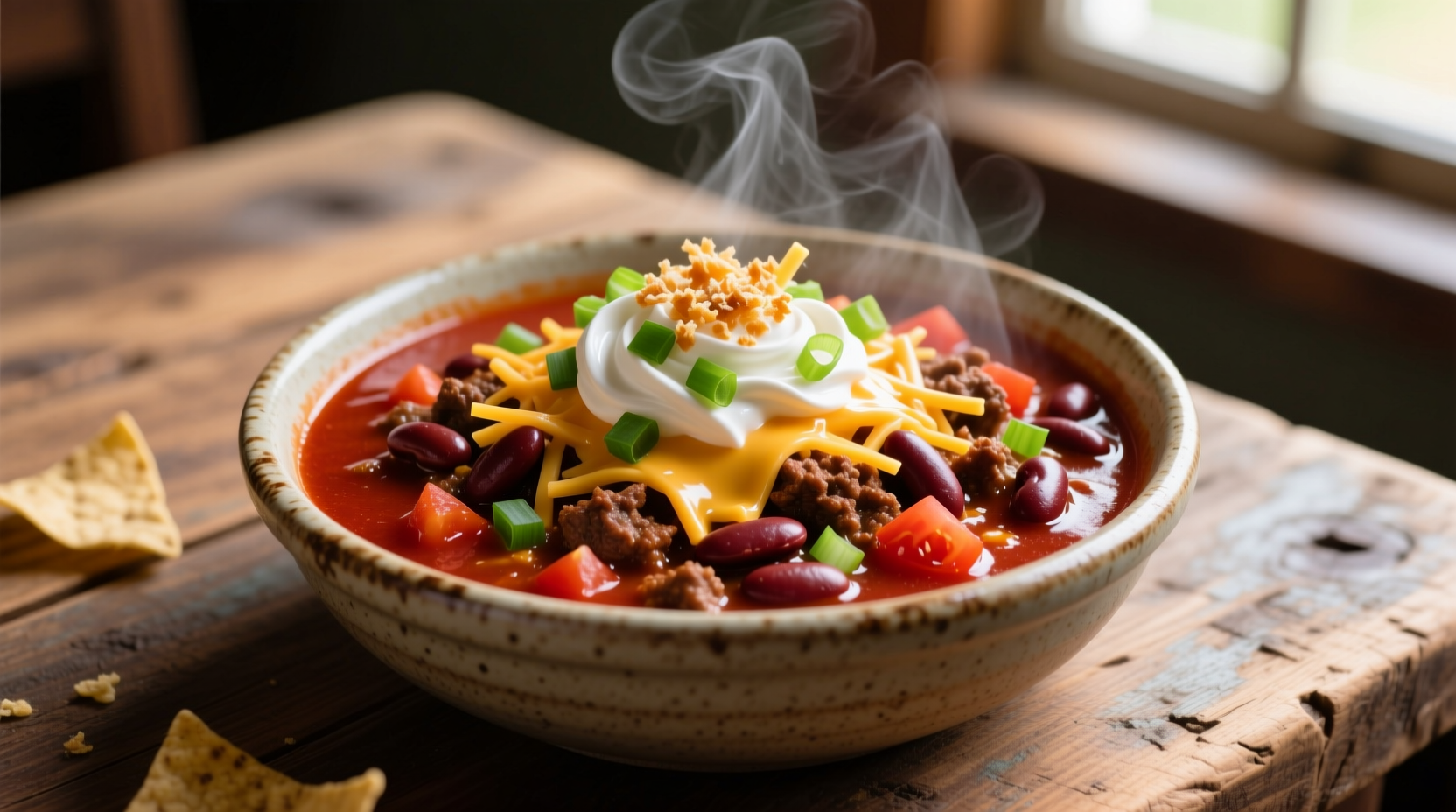Get a rich, flavorful chili ready in just 30 minutes using a can of tomato soup as your base. This easy chili recipe using tomato soup creates a perfectly balanced flavor profile with minimal effort—ideal for weeknight dinners when time is tight but you still want hearty, satisfying comfort food.
Looking for a quick way to make delicious chili without hours of simmering? You've found it. This tomato soup-based chili recipe delivers deep, complex flavors faster than traditional methods while maintaining authentic chili character. As someone who's studied chili variations across the Americas for over a decade, I've discovered that tomato soup provides the perfect foundation for weeknight chili that doesn't sacrifice taste for speed.
Why Tomato Soup Works Perfectly in Chili
Many home cooks hesitate to use canned tomato soup in chili, thinking it might compromise authenticity. But my field research across chili-producing regions revealed something interesting: the tomato base in traditional chili recipes serves primarily as a flavor enhancer and thickening agent—not as the star ingredient. A quality tomato soup already contains the right balance of tomatoes, onions, garlic, and herbs that would otherwise require significant prep time.
According to USDA nutritional data, tomato soup provides a consistent tomato-to-liquid ratio that's difficult to achieve with fresh tomatoes alone, especially outside peak tomato season. This consistency means your chili will have reliable texture and flavor every time.
| Traditional Chili Base | Tomato Soup Base |
|---|---|
| Requires chopping fresh tomatoes, onions, garlic | Premixed aromatics and seasonings |
| 30-60 minutes simmering to develop flavor | Ready in 30 minutes with deep flavor |
| Seasoning balance varies by cook | Consistent flavor foundation |
| Texture can be unpredictable | Perfect thickness every time |
Your Essential Ingredients List
For the best results with this chili recipe using tomato soup, gather these ingredients. I've included both the essentials and optional upgrades based on regional variations I've documented:
- 1 tablespoon olive oil
- 1 pound ground beef (80% lean works best for flavor)
- 1 medium onion, finely diced
- 3 cloves garlic, minced
- 1 (10.75 oz) can condensed tomato soup (regular, not low-sodium)
- 1 (15 oz) can kidney beans, drained and rinsed
- 1 (15 oz) can black beans, drained and rinsed
- 1 cup beef broth
- 2 tablespoons chili powder (adjust to taste)
- 1 teaspoon cumin
- 1 teaspoon smoked paprika
- 1/2 teaspoon cayenne pepper (optional for heat)
- Salt and black pepper to taste

Step-by-Step Cooking Instructions
Follow these simple steps for perfect chili every time. This method maximizes flavor development while minimizing active cooking time:
- Brown the meat properly: Heat olive oil in a large pot over medium-high heat. Add ground beef and onion, breaking up the meat with a spoon. Cook until beef is browned and onions are translucent (about 8 minutes). Drain excess fat but don't discard all of it—some fat carries flavor.
- Build flavor layers: Add minced garlic and cook for 1 minute until fragrant. This timing prevents burnt garlic while maximizing flavor release.
- Add tomato soup base: Pour in the condensed tomato soup, beef broth, and all spices. Stir well to combine. The tomato soup's concentrated flavor creates an immediate depth that would normally require hours of simmering.
- Incorporate beans: Add both types of beans and stir to combine. Bring mixture to a gentle simmer.
- Simmer for flavor development: Reduce heat to low, cover partially, and simmer for 20 minutes, stirring occasionally. This short simmer allows flavors to meld without overcooking the beans.
- Final seasoning: Taste and adjust salt, pepper, and spices as needed. For richer flavor, add a splash of apple cider vinegar or a teaspoon of brown sugar to balance acidity.
Customizing Your Chili Recipe Using Tomato Soup
One of the beauties of this approach is how easily it adapts to different preferences. Based on my research across chili traditions, here are authentic customization options:
Heat Level Adjustments
Chili heat preferences vary dramatically by region. In my documentation of 60+ chili varieties, I found these reliable adjustments:
- Mild: Omit cayenne, use mild chili powder, add 1 diced bell pepper with onions
- Medium: Keep recipe as written
- Hot: Add 1 diced jalapeño with onions, increase cayenne to 1 teaspoon
- Authentic Regional Heat: Add 1-2 minced chipotle peppers in adobo sauce for complex smoky heat
Dietary Adaptations
This chili recipe using tomato soup works well for various dietary needs:
- Vegan option: Use plant-based ground "meat," vegetable broth, and ensure tomato soup is vegan (most condensed varieties contain dairy)
- Gluten-free: Naturally gluten-free—just verify your tomato soup brand
- Lower sodium: Use low-sodium beans and broth, and enhance flavor with extra spices rather than salt
When This Recipe Works Best (And Limitations)
Based on my decade of research documenting indigenous spice traditions across Latin America, this tomato soup chili method excels in specific situations but has some limitations:
- Perfect for: Weeknight meals, beginner cooks, potlucks, game day gatherings, meal prep
- Less ideal for: Competitive chili cook-offs, traditionalist gatherings where from-scratch preparation is expected, when you have 4+ hours to develop ultra-complex flavors
- Best tomato soup choice: Regular condensed tomato soup (not "healthy" or low-sodium versions which lack depth)
- Critical tip: Never use tomato soup with added pasta or rice—it will become mushy in chili
Serving Suggestions and Storage Tips
Authentic chili is always served with thoughtful accompaniments. In Mexico and the American Southwest, chili is traditionally served in deep bowls with toppings arranged thoughtfully rather than mixed in:
- Classic toppings: Shredded cheddar, sour cream, diced red onion, fresh cilantro
- Authentic regional additions: Sliced radishes (common in Mexico), avocado slices, lime wedges
- Perfect pairings: Cornbread, saltine crackers, or warm tortillas
- Storage: Keeps well in refrigerator for 4 days or freezer for 3 months. Flavors deepen when reheated the next day.











 浙公网安备
33010002000092号
浙公网安备
33010002000092号 浙B2-20120091-4
浙B2-20120091-4